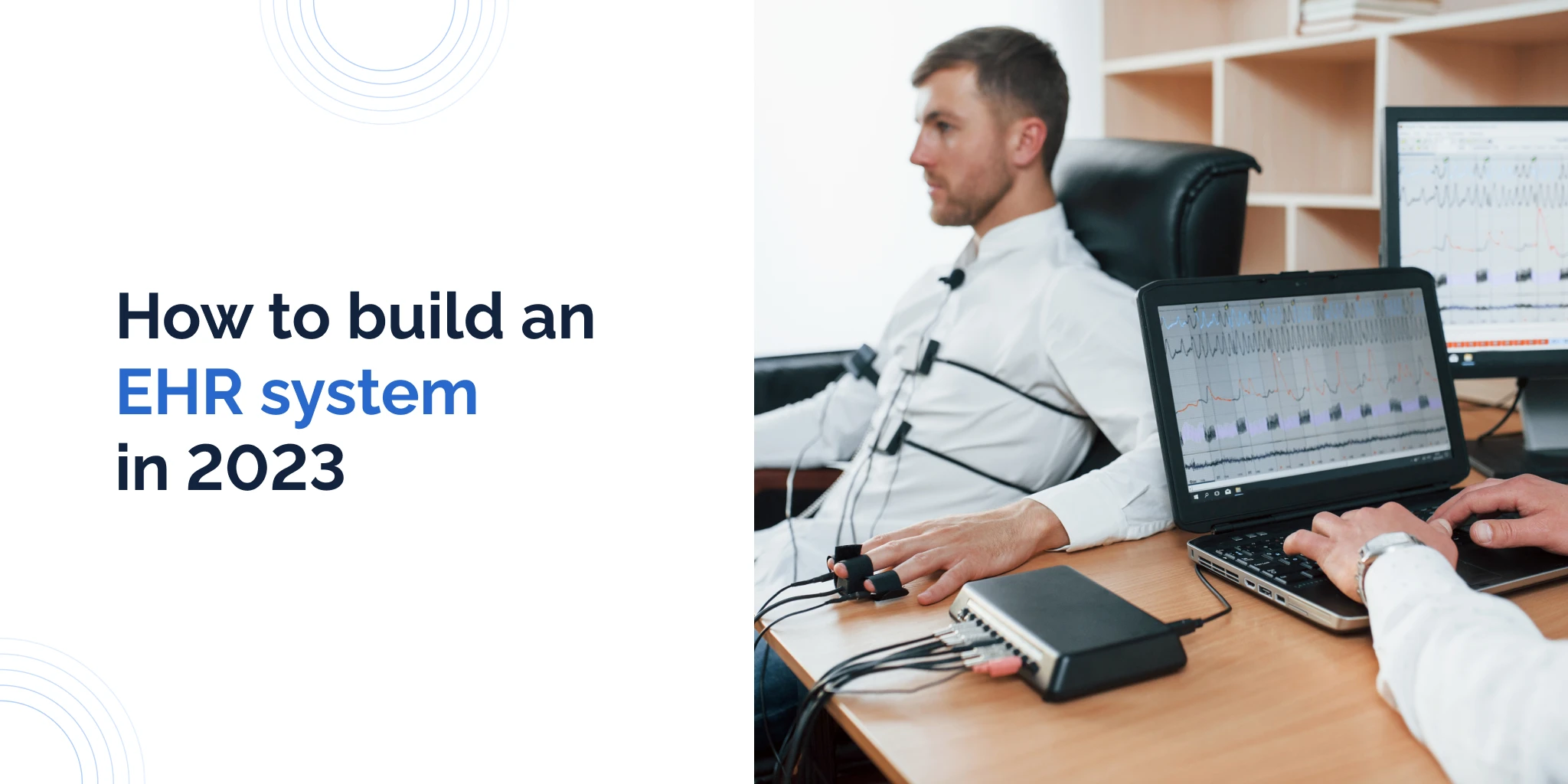If you’re interested in EHR software development, this article is for you. Let’s review the key features of this technology.
The quality of healthcare doesn’t depend on doctors and nurses alone. The US, for example, has some of the best specialists in the world, but its healthcare system is behind the global standards of developed countries. What’s the reason for this strange paradox? How can a system with tremendous healthcare expenditures fail? The key reason is the organization of the relevant healthcare framework. Having great doctors isn’t enough; one should also spread their efforts properly. In this article, we’ll discuss the so-called Electronic Health Records (EHR) systems as they can solve some organizational problems. We’ll look at the benefits, challenges, and features of such frameworks. EHR development can be the key to improving the healthcare outcomes in your facility.
What is an EHR System?
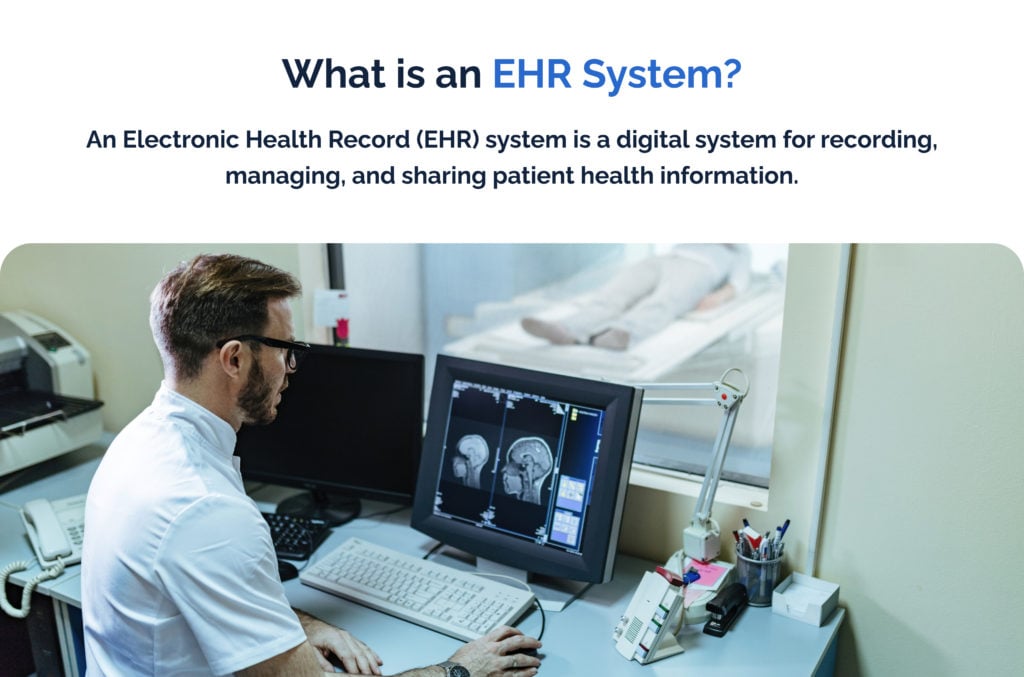
An Electronic Health Record (EHR) system is a digital system for recording, managing, and sharing the health information of a patient. It’s designed to replace traditional paper-based medical records and supply healthcare providers with a complete and up-to-date picture of a patient’s health history. Why are paper-based medical records inferior to EHR frameworks? The reason is simple: EHR systems are specifically designed to improve patient care and outcomes. They enable better communication and coordination among healthcare providers. These systems are also important for population health management and medical research as they offer a wealth of data that can be analyzed to identify trends and inform health policy. An average EHR can, for instance, enable the ability to search through the data via textual inquiries. Such systems are much more complicated for paper-based records. Backing up paper-based records is often impossible: they’re too vulnerable to accidents. EHRs can survive a fire or a hurricane due to the backup systems, allowing one to spread data across multiple devices without effort.
Benefits of EHR Software Development
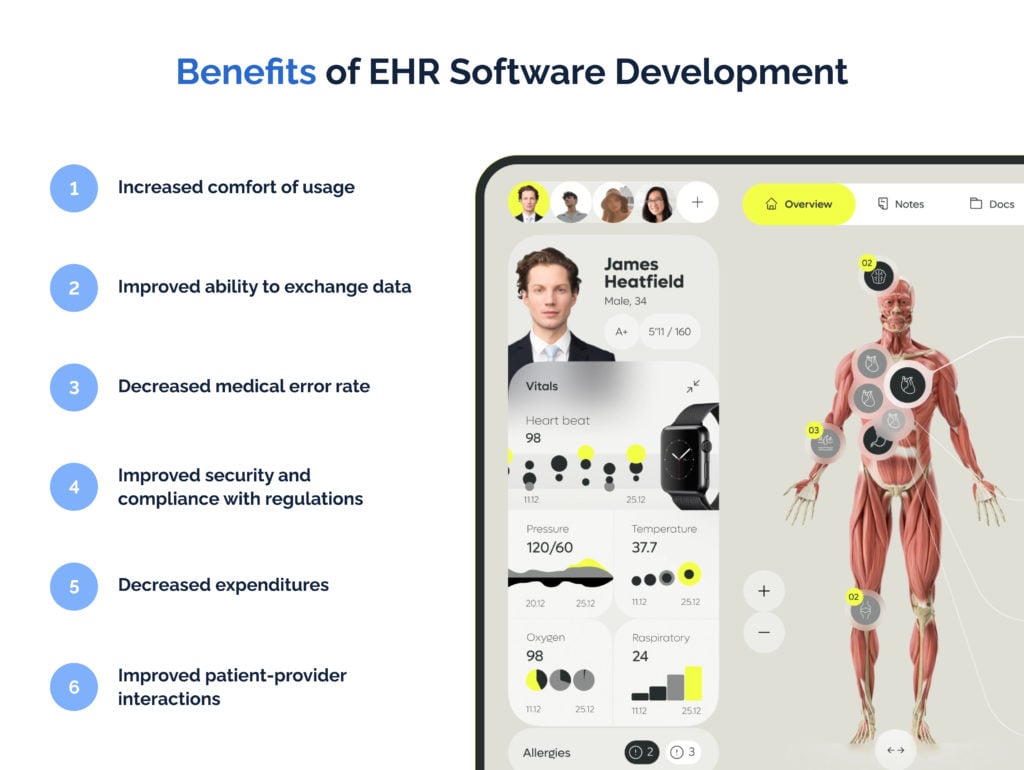
1. Increased comfort of usage
The first reason to engage in EHR development is the ability to boost efficiency and comfort of usage. What do EHR systems offer? Firstly, they enable a convenient space for recording patient information. It’s no longer necessary to use multiple types of paper notes. Instead, the doctors and nurses can write in the data via user-friendly interfaces, allowing many types of configuration. Secondly, as we’ve mentioned, EHR software enables one to search the data more comfortably. Instead of relying on the outdated paper-based archive systems, the specialists can find the necessary information in one or two clicks by opening up a menu and writing in some keywords. Lastly, EHR frameworks are beneficial because they’re available anywhere within the average hospital. One can access the archives from any location instead of visiting a specialized place.
2. Improved ability to exchange data
A major factor for the EHR software development is the higher comfort of exchanging data between hospitals. EHR enables the interoperability of health records. Above all, EHR systems work around similar data storage frameworks. They allow sending information and integrating it into the systems of other hospitals without major barriers. Another reason to use EHR for the presented goals is the greater comfort of interchanging data: sending paper copies of the documents is no longer necessary. One can prepare the data in several clicks.
3. Decreased medical error rate
Paper-based systems have many negative tendencies. They push doctors and nurses toward medical errors. For instance, the records can feature illegible writing; a doctor may also miss some information because the record is overloaded with data. According to Nir Menachemi & Taleah H Collum, the researchers at Department of Health Care, Organization and Policy, University of Alabama at Birmingham, EHRs reduce the risk of errors caused by miscommunication, illegible handwriting, or incomplete records by automating routine tasks and enabling providers to access information quickly and easily. A properly maintained EHR improves the information clarity by removing the key causes of errors.
4. Improved security and compliance with regulations
Paper-based systems are vulnerable to many outside events. Such frameworks can perish in some accident or catastrophe. EHR development removes this problem: having multiple copies of the records is possible. Another factor to consider is that various hospitals feature their approaches to paper-based medical records. This issue often creates the problem of compliance with regulations in the medical field. Creating a compliance-centric system with a high-quality EHR framework is much easier. Existing solutions on the market already consider the demands of regulations such as Health Insurance Portability and Accountability Act (if you want more information about it, we recommend reading the CDC page regarding the legislation). Implementing those standards in custom systems isn’t difficult either.
5. Decreased expenditures
EHR development is a perfect way to decrease the average expenditures of a hospital, according to the Office of the National Coordinator for Health Information Technology. Firstly, it reduces the costs of paper-based record keeping. Secondly, it automates a large number of routine tasks. It’s easier to manage appointment scheduling and prescription refills with the EHR systems. Lastly, the Big Data capabilities of EHR frameworks are also of interest. Using such systems, medical specialists can analyze the interactions between various data types and develop novel treatment methods for certain diseases.
6. Improved patient-provider interactions
EHR software improves patient-provider interactions by offering healthcare providers real-time patient information. This helps providers better understand their patient’s health status and make informed decisions about their care. EHRs can also support patient engagement by enabling patients to access their health records, communicate with their providers electronically, and receive automated reminders for appointments. This feature is crucial for individuals with chronic illnesses. Access to electronic records in such cases can push a person to take their condition seriously and manage it rationally.
Main Features For EHR System
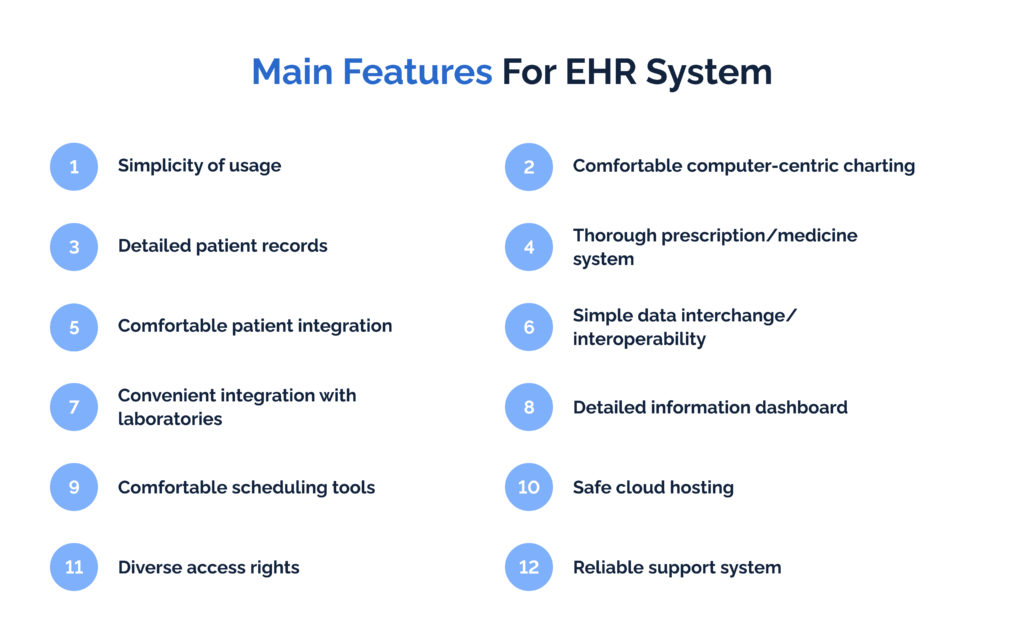
EHR development is a complex process. To create a high-quality system, you need to know the top features. What are those? Let’s look at the following:
1. Simplicity of usage
The first feature you should offer to the clients is a user-friendly interface. Why? The key reason to use an EHR system is to simplify the key work processes. Your interface must be as intuitive as possible. To make an intuitive EHR interface, developers must focus on user-centered design principles, such as clarity and consistency. They should also conduct user testing and gather feedback from healthcare providers to ensure the interface meets their needs and workflows.
2. Comfortable computer-centric charting
Computerized charting in an EHR (Electronic Health Record) is the digital documentation of patient health information in a standardized format. This includes clinical notes on orders, test results, medications, and allergies. If you want to succeed with EHR development, the doctors should have no problems transitioning to the new system. It must feature all the familiar elements of the paper-based framework but in a more convenient computer-centric format.
3. Detailed patient records
Your system must provide multiple formats for the patient records. Doctors should be able to fill in the data regarding the general records and some specific actions (for instance, blood tests). The more options for patient records you provide, the better. Thorough records often ensure that patients receive the care they need.
4. Thorough prescription/medicine system
As the Mississippi State Department of Health proclaims, the US has a massive opioid misuse ‘epidemic.’ What’s the reason? Apart from socio-economic motivations pushing people to abuse opioids, one may note the imperfect medical information record systems. Many doctors don’t have the tools to properly track the purchases and intake of medication. In this light, situations when doctors overprescribe medications are common. EHR development helps resolve this problem. It’s possible to create systems automating prescription management and preventing abuse situations. Using them, an average specialist can see all prescriptions and even the purchase patterns of the patients.
5. Comfortable patient integration
Many of us have at least once faced a situation when accessing the information about our diagnoses was too difficult. Hospitals are often unwilling to offer paper data due to the fear of losing it, for example, or the chaos in the management systems. EHR software development removes this problem once and for all. One can provide the patients with a site offering them access to all the vital health records. Since EHRs store all the data in the cloud, organizing such a site isn’t difficult. All you need is an EHR with online access and a good front-end system for presenting the data.
6. Simple data interchange/interoperability
Some diseases are too difficult for one hospital to manage. Not all facilities know how to deal with cancer or diabetes properly. They can offer some basic help, such as diagnosis, but long-term treatment may require unique equipment. In this light, patient data interoperability is essential. What’s the problem with paper-based records? Many hospitals have unique systems for recording data. This leads to situations when converting health records of one hospital to the standards of another is difficult. EHR can solve this problem. How? The industry features some standards for records that help with simple data interchange. All you have to do regarding features is add support for these systems to guarantee other hospitals/health facilities can receive the vital data without barriers in case of some critical situations.
7. Convenient integration with laboratories
Many laboratories have software for patient tests. If you don’t possess a system to convert this data, the relevant specialists would have to transition it manually. EHR development, thankfully, removes this problem once and for all. By adjusting to the data formats for the test software, it’s possible to convert information without major effort. We recommend adding this feature to your system if the relevant business works with testing facilities.
8. Detailed information dashboard
EHR system development tends to have one minor challenge: it creates a tremendous amount of information for the decision-makers to analyze. In this light, creating systems that can somehow compensate for information overload is crucial. Dashboards are among them: these systems offer key information regarding the hospital or healthcare facility. They also provide insight into the key tasks one should do during the day or week. This feature is crucial for many people because it upgrades organizational capabilities by enabling real-time tracking.
9. Comfortable scheduling tools
Many patients require time-based interventions. EHR development offers a solution to this problem. What should you do? Add the ability to schedule meetings with patients or other tasks into the EHR environment. This approach will allow the doctors to immediately interconnect the patient records with the relevant tasks instead of having to do everything manually. Such an approach reduces errors and lowers the specialists’ fatigue.
10. Safe cloud hosting
How to build an EHR system attracting a maximal number of users? It has to be more reliable than traditional paper systems. In this regard, putting the EHR framework into the cloud is the best idea to consider. A famous saying proclaims you shouldn’t put all eggs into one basket. Cloud solves this problem of paper records. It lets you store the information across multiple locations and with several backups. This means the probability of data loss is minimal in such a situation. For you to lose all the data without a trace, something apocalyptic has to happen. Integrate cloud systems as soon as possible: they’re one of the key ways to preserve patient data.
11. Diverse access rights
Different people in your organization may need diverging data. Since patient information is sensitive, the best option is to limit access to it. In this regard, we have an interesting framework: RBAC. Role-based access control (RBAC) is a security mechanism used to control access to computer systems or networks based on the roles and responsibilities of individual users within an organization. In an RBAC system, access to resources, such as files or applications, is granted based on the user’s assigned role within the organization rather than the user’s identity. RBAC assigns permissions to roles, which are then assigned to users. This approach simplifies security administration in EHR software development and reduces the risk of unauthorized access or data breaches.
12. Reliable support system
The final element every EHR system needs is a reliable support system. EHR software development has one significant downside: some errors eventually disrupt the system. No software works without bugs, regrettably. In this light, it’s essential to have people who can support you in case of some problems. Support should stem from people who engage in EHR system development. The relevant development company must have a specialist who can assist you with bugs or user interface questions. If you use EHR without support, you’ll inevitably encounter unsolvable problems.
Challenges in EHR Software Development
EHR software development also has some challenges. What are those? Let’s look at the following:
1. Compliance with key standards: GDPR and HIPAA
Governmental healthcare organizations have multiple standards for hospital-oriented software. If you fail to follow them, there’s a high likelihood of encountering some fines. What are those standards? As OneTrust company notes, these are GDPR and HIPAA. GDPR (General Data Protection Regulation) is a regulation in the EU that governs the processing and protection of personal data for local citizens. HIPAA (Health Insurance Portability and Accountability Act) is a US law that sets national standards for protecting sensitive patient health information. You shouldn’t start EHR software development without considering those frameworks
2. Certifying EHR software
Your software should also go through certification. EHR system development requires strict adherence to all standards. Who certifies the relevant data? Different regions have their organizations. In the United States, for instance, the Office of the National Coordinator for Health Information Technology (ONC) certifies EHR systems for compliance with standards and regulations. ONC-Authorized Testing and Certification Bodies (ONC-ATCBs) conduct the actual testing and certification process, according to the official governmental websites.
3. Ensuring interoperability
Another challenge for many organizations in EHR system development is interoperability itself. To ensure interoperability between healthcare systems, adopt industry standards like HL7 and FHIR and use APIs for data exchange. The key challenge here is finding a company that can do this. In this regard, our firm, Keenethics, delivers services of such type.
4. Creating a comfortable UI/UX
How to build an EHR system that’s successful? You have to offer a comfortable user interface. If your app is feature-rich but hides the functions behind cumbersome UI elements, it’ll likely attract only a small number of stakeholders at best. Why is UI/UX a challenge? Many companies claim they know how to work with it but, in reality, fail at delivering high-quality options. We believe engaging in practices such as wireframing, prototyping, and user interviews is crucial to achieving a good UI/UX. Regrettably, these efforts are time-consuming, and that’s why they’re a challenge.
The Most Important EHR Software Requirements
Let’s look at some key EHR software requirements. Here are the features you should add as soon as possible:
1. Document reviewing
Your software should work with a maximum number of data formats. One must have an opportunity to review Word and PDF files to ensure maximum comfort.
2. Patient’s information management
How to build an EHR system that works? It has to offer comfortable access to key patient information. Patients and doctors must have access to comfortable and personalized user profiles.
3. Prescription control
We’ve already mentioned massive problems with opioid addiction in the US. They stem from many factors, which also involve bad prescription systems. This means a rational counter strategy includes a framework capable of tracking prescription medication purchases.
4. Access management system
A vital system to consider is access management. Certain information should be available only to particular roles. In this light, one must add a tool splitting the workers into different access groups according to their responsibilities.
5. Appointment framework
How to build an EHR system that’s not confusing? It must provide a maximum number of tools to the users. In this regard, an appointment framework is among them. The doctors/nurses must have an opportunity to connect appointments to user records. This approach will simplify the management of the key information.
6. Report system
Every doctor/nurse has to offer reports on their activities. Add such capabilities during the EHR software development process. One should be able to generate reports automatically from appointment data, such as diagnoses presented during a workday.
7. Integration with laboratories
You should also think about integrating the test data from laboratories. How to build an EHR system that supports their integration? Integrate some key standards used for test records and provide conversion tools for the users. In many cases, all you need is a good PDF viewer.
8. Finance managing/invoicing
We believe a good EHR system should integrate as many functions as possible. Financial information is also a part of health records. If you store them separately, it’s easy to confuse some specialists. Instead, your EHR software should have invoices as an integral part. Every payment document must immediately appear in the proper tab within the EHR system.
Tech Stack For EHR Software Development
Choosing relevant technology for EHR software development
How to build an EHR system? Good technology stacks for Electronic Health Records (EHRs) typically include a combination of database technologies, server-side frameworks, and front-end development tools. Popular stacks include Java with Spring and Hibernate, .NET with Entity Framework, and MEAN (MongoDB, Express, Angular, Node.js). In this case, Node.js and React JS are great choices for building EHRs if you want to develop an online-based product. Our team specializes in these technologies, so you can address us for this type of development.
Creating a high-quality team
Another vital aspect of EHR development is finding a good team. Firstly, we recommend working with individuals who can develop both front-end and back-end. Secondly, it’s crucial to see if the relevant team members have experience developing healthcare apps. Lastly, the overall partner business experience in the field is crucial: companies that achieve longevity are the most likely to offer you long-term support.
Architecture of an EHR System
How to create an electronic medical record system with useful features? You should consider a proper architecture for this framework. The architecture of Electronic Health Record (EHR) systems typically involves multiple levels. The application layer provides the logic for processing data and interacting with external systems, while the data access layer manages communication with the database layer. Lastly, the database layer stores the actual patient data and is responsible for ensuring information integrity and security.
Front-End Development
Front-end systems, in this case, involve the user interface and application layer. Their goal is to interconnect the program’s code with a comfortable user experience. Our company uses Node.js and React JS for these goals.
Back-End Development
As for the back end, it involves a data access layer (it can be written in Node.js, for example, or Java) and the database itself (multiple technologies such as MongoDB work in this case).
Things to Think About When Developing EHR Software
How to build an EHR system? We’ve already mentioned the key features you need. Here’s a cheat sheet that summarizes the key elements:
- User needs and workflows;
- Regulatory compliance, including HIPAA and GDPR;
- Data security and privacy;
- Interoperability with other healthcare systems;
- Scalability and performance;
- System integration and data exchange;
- User interface design and usability;
- Testing and quality assurance;
- Ongoing maintenance and support;
- Legal and liability considerations.
How to Build an EHR System?
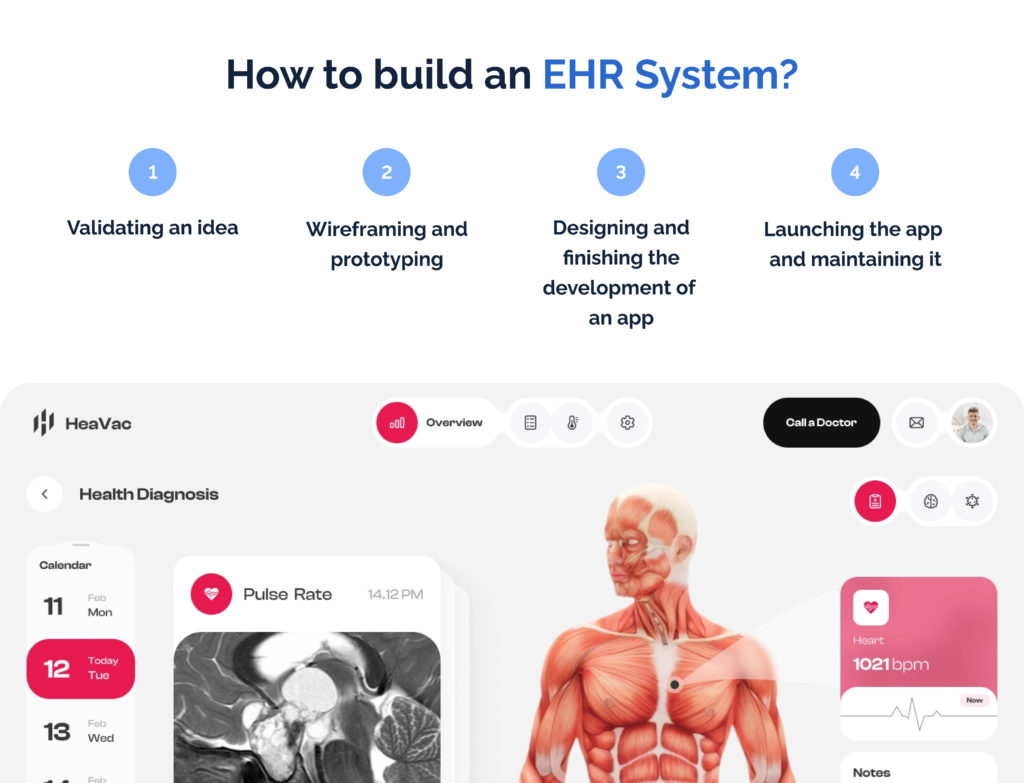
We’ve discussed the features you need for an EHR system, but what about the strategy? We now know what to build during EHR software development, but how to approach app creation as a process?
1. Validating an idea
The first step you should consider in EHR software development is validating an idea. What to do here? Outline your app’s features and then go through a set of tests (for instance, the riskiest assumption test) to see if they make sense. In this stage, it’s also crucial to outline how long development should take. Generally, you have to describe the overall framework of app creation.
2. Wireframing and prototyping
How to develop an EHR safely? Your goal is to, above all, test if your ideas work at all. You need two key activities, wireframing and prototyping. Firstly, one should outline the user interface used for a particular app. Secondly, creating a prototype of your app and testing it on real users may be crucial. A minimum viable version of the app is essential to see if your intuition regarding the relevant app makes sense.
3. Designing and finishing the development of an app
Once you understand that your EHR framework functions, it’s time to focus on finishing the development process. Choose the most viable design features discovered during the testing/prototyping phase and present them in a real application. You should continue testing every development phase to ensure your app offers users a maximum number of features. The idea is to finalize all the elements and start a full-scale product.
4. Launching the app and maintaining it
The final step in EHR system development is deploying the app in a real environment. The release version should feature a minimum of bugs if you want to avoid resistance on the part of the users. Upon ironing out all remaining problems, it’s essential to focus on app development and creating new features. In the next section, we discuss some things you can add.
What to Care About After the EHR Development
Here are some things you should care about after the EHR development:
Preparing the key certifications
Every good EHR system has to feature high-quality certifications. You should go through the relevant process in your home country to avoid legal problems.
Creating a mobile version of an EHR
How to develop an EHR that is as comfortable as possible? We believe the best choice is to make it available on multiple platforms. Personal computers are great, but they have problems with portability. When you present an EHR system for mobile platforms, the relevant healthcare specialists will have more mobility options.
Creating comfortable migration tools
If you try EHR systems for the first time, your healthcare facility likely keeps old records in paper format. To guarantee maximum efficiency and data safety, it’s crucial to present tools that enable a fast transition. One should have comfortable forms for transitioning written data and scanning tools to maintain the photocopies of the relevant information.
Analyzing the system performance
The final step to consider is the analysis of the relevant performance. Collect as much data about your system as possible to understand what features require changes. It’s impossible to weed out all issues during prototyping: you must constantly be on the watch regarding potential problems.
Cost of EHR System Development
The existing research highlights that implementing an EHR system costs an average of 15 to 75 thousand dollars. This figure is, of course, approximate because every country has its development costs. How to create an electronic medical record system at a relatively low price? Try out the developer services in Eastern Europe. For example, our company is based in Ukraine, and we offer development costs between 25 and 50 dollars per hour of the developer’s time.
How Can Keenethics Help With Your EHR Project?
Keenethics has been developing finance, education, and healthcare products for several years. This means we have enough experience to help you create a high-quality project. Our business is behind apps such as Blood Test Application, OneRemission, and uMore. They help customers with tests, assist cancer patients, and provide comfortable management of mental health problems, respectively.
Conclusion
This article should provide enough information on the key inquiry you likely have: “How to build an EHR system?” If you have any further questions after reading this material, you can always address our team. We have many interesting development options for EHR software and can assist you with choosing the right solution for your business.
FAQs about EHR development
What does EHR stand for?
EHR stands for Electronic Health Record system. An Electronic Health Record is a digital version of a patient’s medical history maintained by healthcare providers and organizations.
What types of EHR systems exist?
The types of EHR systems include cloud-based, web-based, client-server, and hybrid models.
What is the cost of an average EHR system?
An average EHR costs between 15000 and 75000 dollars. Larger projects may be more expensive.
What should I consider while building an EHR?
When engaging in EHR software development, consider compliance with healthcare regulations, data security, interoperability, user experience, and scalability.
If you want to install one, address our company!

